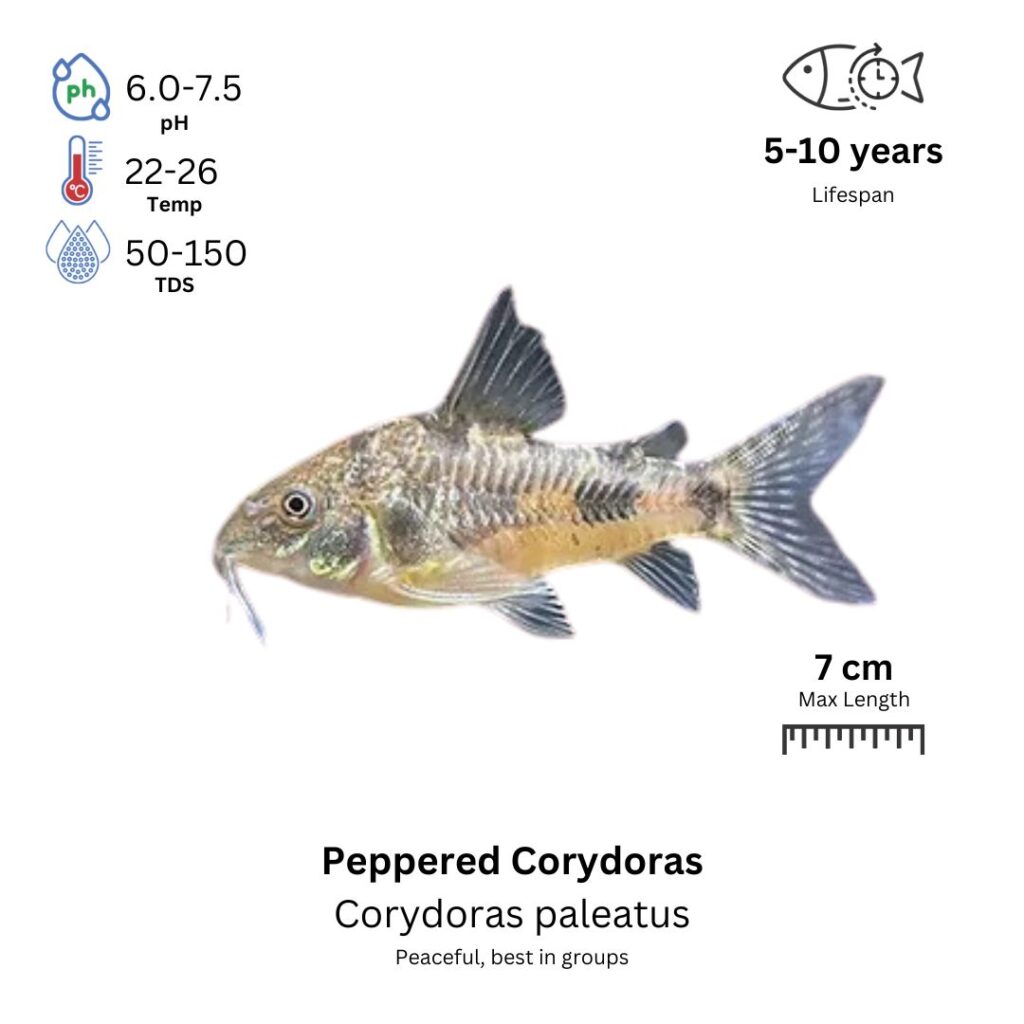Peppered Corydoras
Corydoras paleatus

Description
The Peppered Corydoras is a small, peaceful freshwater catfish known for its speckled appearance, with a light gray to tan body adorned with small black spots, resembling “pepper” all over its body. This pattern is what gives the species its common name. Their smooth, armored bodies are designed to protect them from predators. They have long whisker-like barbels around their mouths, which they use to detect food on the substrate. Peppered Corydoras are social and calm, typically seen swimming in groups and spending their time scavenging the bottom of the tank for food. They are excellent scavengers and help keep tanks clean.
Habitat Origin
Native to South America, particularly found in slow-moving rivers and streams in countries like Brazil, Argentina, and Paraguay. They thrive in areas with sandy or fine gravel substrates and dense vegetation.
Aquarium
Ideal Number in Aquarium: At least 4-6 individuals, as they are schooling fish and feel more secure in groups.
Favorite Food

Peppered Corydoras are omnivores and will eat a variety of foods. They enjoy sinking pellets, flakes, and live or frozen foods like bloodworms, brine shrimp, and daphnia. They also graze on algae and detritus found on the tank substrate. A varied diet is important for their health and well-being.
Behavior:
Peppered Corydoras are peaceful and non-aggressive, making them excellent tankmates for community aquariums. They are bottom-dwellers and prefer to stay close to the substrate, where they can search for food. They are social and thrive in groups, displaying charming schooling behavior. While they are not particularly active swimmers, they are constantly foraging for food and interacting with one another. Due to their gentle nature, they are ideal for tanks with other peaceful species.
Special Care:
These fish require a soft, fine substrate, such as sand or smooth gravel, to avoid damaging their sensitive barbels. Providing hiding spots, like plants, driftwood, or caves, will help them feel secure. A tank with stable water parameters and a good filtration system is essential, as these fish are sensitive to poor water quality. Regular water changes are important for keeping their environment clean and healthy.
Compatibility with Other Fish:
Yes, Peppered Corydoras are compatible with most peaceful community species, including small tetras, rasboras, and shrimp. They should be kept with other peaceful, non-aggressive species. Avoid keeping them with large, aggressive fish or species that might see them as prey. These fish are bottom-dwellers, so it’s essential not to overcrowd the substrate with other bottom-feeding species.
Breeding Tank Setup
While not absolutely required, using a separate breeding tank is highly recommended to improve the chances of successful egg survival. Corydoras eggs are sticky and often laid on plants, glass, or decorations, making them vulnerable in a community tank. A 10-gallon tank (38 liters) is suitable for a small group; for multiple pairs or larger groups, a 20-gallon tank (75 liters) is better. Ideal parameters include pH 6.0–7.5, temperature 22–28°C (72–82°F), and moderate hardness (4–12 dGH). Use fine gravel or sand, and add live plants like Java moss or Anubias to offer spawning surfaces. A gentle sponge filter is ideal for low current and safe filtration.
Conditioning Adults for Breeding
Before breeding, Peppered Corydoras should be conditioned with a nutritious, protein-rich diet. Offer high-quality pellets, live or frozen foods such as brine shrimp, daphnia, or bloodworms, and occasional blanched vegetables like spinach or zucchini. Perform regular weekly water changes (20–30%), and trigger spawning with a larger 50% water change and a slight increase in temperature to 26–28°C to mimic rainy season conditions, which naturally initiate spawning behavior in the wild.
Spawning Behavior
Spawning usually occurs in the early morning, following favorable water changes. Males will chase the female, and the female will then lay eggs on various surfaces, which are immediately fertilized by the male. A female can lay 50 to 150 eggs per session, depending on her size and condition. Once eggs are laid, it’s essential to remove the adults from the tank to prevent them from consuming the eggs. The eggs are sticky and adhere well to smooth or leafy surfaces, where they will remain until hatching.
Fry Hatching & Feeding
The eggs hatch within 3–5 days, depending on water temperature. The newly hatched fry will survive on their yolk sacs for the first couple of days. Afterward, begin feeding infusoria or liquid fry food, then transition to baby brine shrimp or microworms as they grow. As they mature, finely crushed pellets or flakes can be introduced. Maintain excellent water quality by performing frequent small water changes (10–20%) every 1–2 days, and ensure the temperature remains stable between 24–28°C for optimal development.
Additional Tips & Sexing Adults
Peppered Corydoras reach breeding maturity at around 6 months. Males are usually slimmer and more active, while females are rounder and larger, particularly when carrying eggs. During breeding season, males may show more vibrant colors. Avoid sudden environmental changes or poor water quality, as these can stress the fish and disrupt breeding. Ensure a calm environment with non-aggressive tank mates, and prioritize clean, well-oxygenated water throughout the breeding and fry-rearing process.
